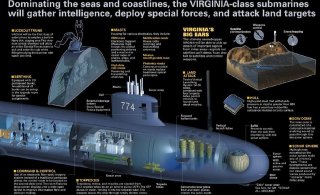SSN(X): The U.S. Navy Has Big Plans for a New Attack Submarine
The SSN(X) design places greater emphasis on Anti-submarine Warfare (ASW) by increasing the SSN(X)’s transit speed and stealth features and characteristics over the current Virginia-class nuclear attack sub.
The United States Navy is now expected to receive delivery of nine of the Virginia-class Block V submarines between 2025 and 2029, and eight of those will be equipped with the Virginia Payload Module – a mid-body section that will increase the overall length of the boats.
However, the development of the successor to the Virginia-class is already underway, as part of the U.S. Navy "Next-Generation Attack Submarine" – SSN(X) program. It is expected to incorporate advanced technologies and capabilities to ensure that the new submarines will be able to meet the evolving challenges of the modern maritime environment.
The U.S. Navy's proposed Fiscal Year 2023 (FY23) budget had requested $237.0 million in research and development funding for the SSN(X) program. The service has further stated that the SSN(X) will be designed to counter the growing threat posed by near-peer adversary competition for undersea supremacy, as the new class of boats will provide greater speed, increased horizontal payload capacity, improved acoustic superiority, and higher operational availability.
SSN(X) will reportedly be able to conduct full spectrum undersea warfare and further coordinate with a larger contingent of off-hull vehicles, sensors, and friendly forces.
According to the U.S. Navy, the SSN(X) will retain and improve multi-mission (Anti-submarine warfare (ASW), Anti-surface warfare (ASuW), Strike, Special Operating Forces (SOF), Mine, Subsea Seabed Warfare (SSW), Intelligence, Surveillance and Reconnaissance (ISR)) capability and sustained combat presence in denied waters.
SSN(X): What We Know
Details about the actual designs of the new class of nuclear-powered fast attack submarines have not been publicly released and are expected to change and evolve as the project is still in development. However, it has been reported that the new class which is being developed via a partnership between Huntington Ingalls Industries' Newport News Shipbuilding division and General Dynamics Electric Boat, could enter service by the early 2040s.
U.S. Navy officials want to procure the first SSN(X) in FY2035 and have it delivered to the Navy in FY2042.
Along with the Columbia-class ballistic missile submarine, the SSN(X) program has been seen as a critical component of the U.S. Navy's future submarine force and is expected to play a key role in maintaining the United States naval superiority in the coming decades.
Despite the projected schedules, it is not yet clear when the SSN(X) program will be fully developed and deployed, though it is likely to be a major focus of the U.S. Navy's research and development efforts over the next decade.
As previously reported, the SSN(X) design places greater emphasis on Anti-submarine Warfare (ASW) by increasing the SSN(X)’s transit speed and stealth features and characteristics over the current Virginia-class nuclear attack sub.
Moreover, the SSN(X) will also carry more weapons and a more diverse payload than the Virginia subs to deal with more advanced enemy submarines and unmanned underwater vessels (UUVs), and be able to coordinate with allied warships and forces.

The future fast attack subs could be equipped with and/or utilize laser weapons, conformal bow sonar, quantum technology, larger weapons stowage compartments, additional torpedo tubes, very large flank arrays, quieter electric drive propulsion, X-rudder for better maneuverability, and VLS for cruise missile and future hypersonic weapons.
The exact capabilities of the SSN(X) have yet to be disclosed.
Costs Could Rise
The program's cost was noted in the October 2023 Congressional Budget Office (CBO) report on the U.S. Navy's FY2024 30-year shipbuilding plan states that in constant FY2023 dollars, the SSN(X)'s average unit procurement cost is estimated at $6.7 billion to $7.0 billion by the Navy and $7.7 billion to $8.0 billion by CBO.
The government watchdog estimates were about 14 percent to 15 percent higher than the U.S. Navy's estimate. The CBO report states that its estimate assumes that the SSN(X) design would have a submerged displacement of about 10,100 tons, about 11 percent more than that of the SSN-21 design.
Issues For Lawmakers
The Congressional Research Service (CRS) also addressed several issues that lawmakers in D.C. should consider, including whether the Navy has accurately identified the SSN(X)’s required capabilities and accurately analyzed the impact that various required capabilities can have on the SSN(X)'s cost.
CRS also called for Congress to determine the potential impact of the SSN(X) program on funding that will be available for other Navy program priorities, particularly if CBO's estimate of the SSN(X)'s procurement cost is more accurate than the Navy's estimate; and whether it would be technically feasible for the SSN(X) to be powered by a reactor plant using low-enriched uranium (LEU), rather than the highly enriched uranium (HEU) used on other Navy nuclear-powered ships, and if so, what impact that would have on nuclear arms control and nonproliferation efforts and SSN(X) costs and capabilities.
Finally, CRS noted that lawmakers should consider whether each SSN(X) should be built jointly by GD/EB and HII/NNS (the approach used for building Virginia-class SSNs and, in modified form, for building Columbia-class SSBNs), or whether individual SSN(X)s should instead be completely built within a given shipyard (the separate-yard approach used for building earlier Navy SSNs and SSBNs).
The SSN(X) won't be in the water for at least another decade, and it likely won't be smooth sailing to get there.
Author Experience and Expertise
Peter Suciu is a Michigan-based writer. He has contributed to more than four dozen magazines, newspapers, and websites with over 3,200 published pieces over a twenty-year career in journalism. He regularly writes about military hardware, firearms history, cybersecurity, politics, and international affairs. Peter is also a Contributing Writer for Forbes and Clearance Jobs.
All images are Creative Commons.

